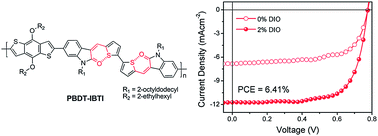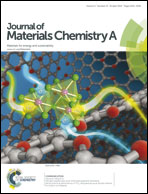An expanded isoindigo unit as a new building block for a conjugated polymer leading to high-performance solar cells†
Abstract
Design and synthesis of novel monomers may create new opportunities for high performance semiconducting polymers. The synthetic modification of an isoindigo related building block based on rational design has been carried out in this study. An expanded isoindigo unit (IBTI) with 5,5′-divinyl-2,2′-bithiophene as a conjugated bridge has been successfully incorporated into a donor–acceptor conjugated polymer, PBDT–IBTI. The new polymer showed broad absorption and a large extinction coefficient in the visible region. The optical bandgap, HOMO and LUMO levels of this new polymer are 1.71 eV, −5.24 eV and −3.72 eV, respectively. The polymer solar cells based on PBDT–IBTI and (6,6)-phenyl-C61 butyric acid methyl ester (PC61BM) blends achieved a PCE of 6.41%. This work has demonstrated that IBTI is a promising building block for organic photovoltaic (OPV) polymers. These findings have also revealed the versatility of oxindole as the basic building element for isoindigo-like conjugated monomers.


 Please wait while we load your content...
Please wait while we load your content...